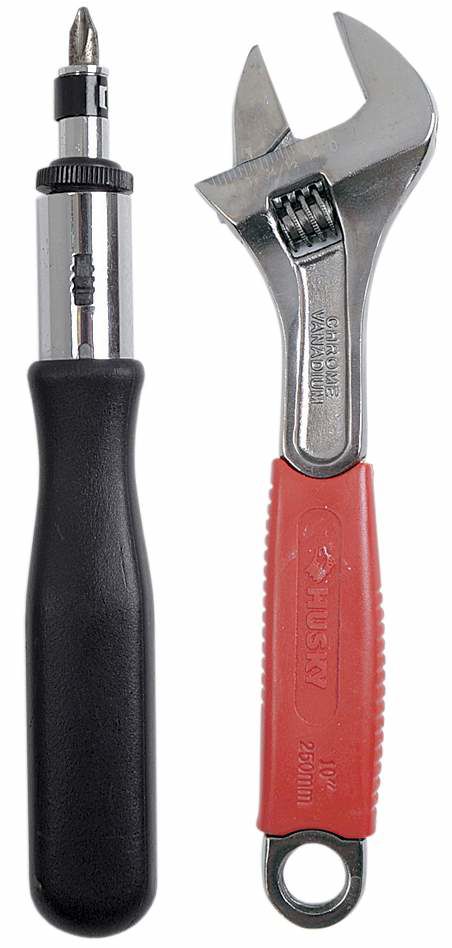Plumbing tools to have, tasks to do
Published 5:00 am Tuesday, August 30, 2011

- Phillips head screwdriver: Many fixtures are attached with a Phillips head bolt, making this tool a must-have for removing them. A crescent wrench can be used to take off a faucet or hose.
If the water flows and it shouldn’t or if the water doesn’t flow and it should, you have a plumbing problem.
That situation is generally what brings people in to shop for their first plumbing tools, says Scott Steinbrecher of Searing Electric and Plumbing in Bend.
“With the right tools, most people can do many of the basic plumbing tasks,” Steinbrecher said. “One of the most common problems is a stopped-up toilet, and most people can fix it. If you call a plumber, it will probably cost about $85.”
That amount is based on the standard service- call fee, he said, because plumbers have to figure in travel time, and one hour is typically the minimum amount of time charged.
The next most common plumbing problem, Steinbrecher said, is when the P-trap on a sink, bathtub or shower gets stopped up. Again, a plumber will be expensive.
Just about anybody can clean a P-trap, unclog a toilet and fix a leaky faucet, Steinbrecher said, provided the right tools are available. Every homeowner should also know how to shut the water off from the main line, he added.
But what basic plumbing tools does a neophyte need?
According to my dad, the traditional items needed to start building any homeowner’s tool kit are duct tape and WD-40. Using them is simple: If it moves and it shouldn’t, use duct tape. If it doesn’t move and should, use WD-40. Then, get a pair of vice grips and a steel measuring tape and build on this foundation.
When I left home many years ago, dad and I went out to the shop and he gave me one of every tool he had duplicates of. I carried on this tradition last year when my son moved to Portland.
But for those people who don’t have the advantage of this parental guidance, here are some suggestions for starting a beginner’s plumbing tool kit:
Plungers: The “plumber’s friend” may be the most used and useful of plumbing tools.
Toilet auger (or snake): This tool, a 4- to 5-foot-long flexible line with a crank on one end and a set of hooks on the other, will unplug virtually any stoppage. The end with the hooks is inserted down the commode drain. When it reaches the clogging agent, it is twisted with the crank on the end. This will either snag the object so it can be removed or break up the material so it can be flushed. An auger is probably the first tool a plumber reaches for to unclog a toilet.
Zip-It Drain Cleaner: This long piece of plastic with teeth on it will unclog a sink, shower or bathtub P-trap without having to remove the fixture. Removing a P-trap can be quite a chore. It involves removing a section of pipe under the drain by loosening and removing two connectors. The pipe is typically full of water, so extreme care must be taken not to spill it all over everything. A Zip-It takes hair out of showers and sinks without complete disassembly required. If you drop your wedding ring or an earring down the sink, though, the P-trap will still have to be removed.
Channel lock and/or pipe wrench: If a P-trap or fixture must be removed, you’ll need something large enough to go around the pipe.
Vice grips and/or crescent wrench: If a faucet or hose must be taken off, a crescent wrench will usually do the job. The vice grips can be clamped on a faucet stem to shut it off, or on a smaller, round copper pipe.
Phillips head screwdriver: Most faucets and fixtures are attached with a Phillips head bolt, so you’ll need something to remove it.
Plumber’s grease: If a faucet must be lubricated — because it is hard to operate or squeaks when the water runs — this grease lasts longer and will not wash off as quickly as some petroleum-based products.
Water shut-off key: If a water pipe breaks inside the house, the situation worsens each moment the deluge continues. Every house should have a shut-off key, to shut the house off from the main line. The key should be kept where it is easily found and all the adults in the house should know how to use it in order to shut the water off quickly. Then call a plumber.
Teflon tape: Use this to seal the threads on a shower head or other fixtures.
Drain cleaner: Sometimes a shot of cleaner is all it takes to break up a clog or stoppage in a drain. Care should be exercised when it is used because some of the harsher cleaners are caustic and toxic.
Radiator hose bandage: Technically, this is an automotive tool, but it can work very well as a first aid measure around a burst or leaking pipe. The bandage can be put around the break and tightened down to stop damage until the plumber arrives.






